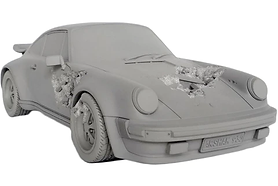Daniel ARSHAM

Daniel Arsham Future Relic 06 Polaroid

Daniel Arsham Future Relic 05 Telephone

Daniel Arsham Eroded 911 Turbo Grey

Daniel Arsham Eroded Delorean White

Daniel Arsham Future Relic 02 35mm Camera
BIOGRAPHY
Daniel Arsham's creations are based on his concept of fictional archaeology. Working in the fields of sculpture, architecture, drawing and cinema, he creates spaces and situations where he stages what he describes as the future relics of the present.
These works are skilfully made from materials such as sand, selenite or volcanic ash, so that they appear to have been recently discovered, after centuries of burial. Most of the objects he transforms into stone are classic and iconic everyday objects of the 20th century.
The Future Relic series, produced and edited from 2013 to 2018, includes, for example, nine different sculptures: a mobile phone (first generation), a camera with its lens, a needle alarm clock, an audio cassette with magnetic tape, a landline telephone keys, a Polaroid type camera, an audio cassette player, a radio, and a musical keyboard synthesizer. All the sculptures are published in 500 copies and are made of plaster with inlays of glass fragments. The process developed to make them has the particularity of producing unique works each time. More clearly, the erosion is different for each work.
For all his works, Daniel Arsham works a lot on the process. Despite its apparent simplicity, the result is the fruit of hard work. In fact, more than a year can pass between the initial drawing and the final piece. In the beginning, a long period of research and development was needed to establish the right crystallization technique and perfect texture. For example, most of his works are made from geological rocks, such as volcanic rock or quartz. Then each time, the first draft must be adapted in plaster, to then be transformed into the final sculpture. Sometimes projects are impossible, in which case they must be abandoned. This process is also a way for Arsham to question the limits of artistic creation.
How far is he willing to go for a job he cares about? At what moment does he arbitrate between the importance of his creation and the time necessary for its realization? Moreover, in his Paris 3020 exhibition, the artist pushed the limits of his creative process even further. In order to produce life-size reproductions of emblematic statues, such as the Venus de Milo or the Seated Moses by Michelangelo, he collaborated closely with the moulding workshop of the Réunion des Musées Nationaux (RMN). Using quartz, gypsum cement and blue calcite, Arsham used the same materials as those for classical sculpture, while adding his personal touch with crystallization. The result? He succeeded in breathing new life into what had gone before, projecting his new vision, erasing all boundaries between past, present and future.
The Class Art Biarritz gallery offers multiple sculptures by Daniel Arsham.
More information about Daniel ARSHAM on our blog:
-Eroded Delorean sculpture 10 years anniversary !
-We visited the MOCO museum in London


